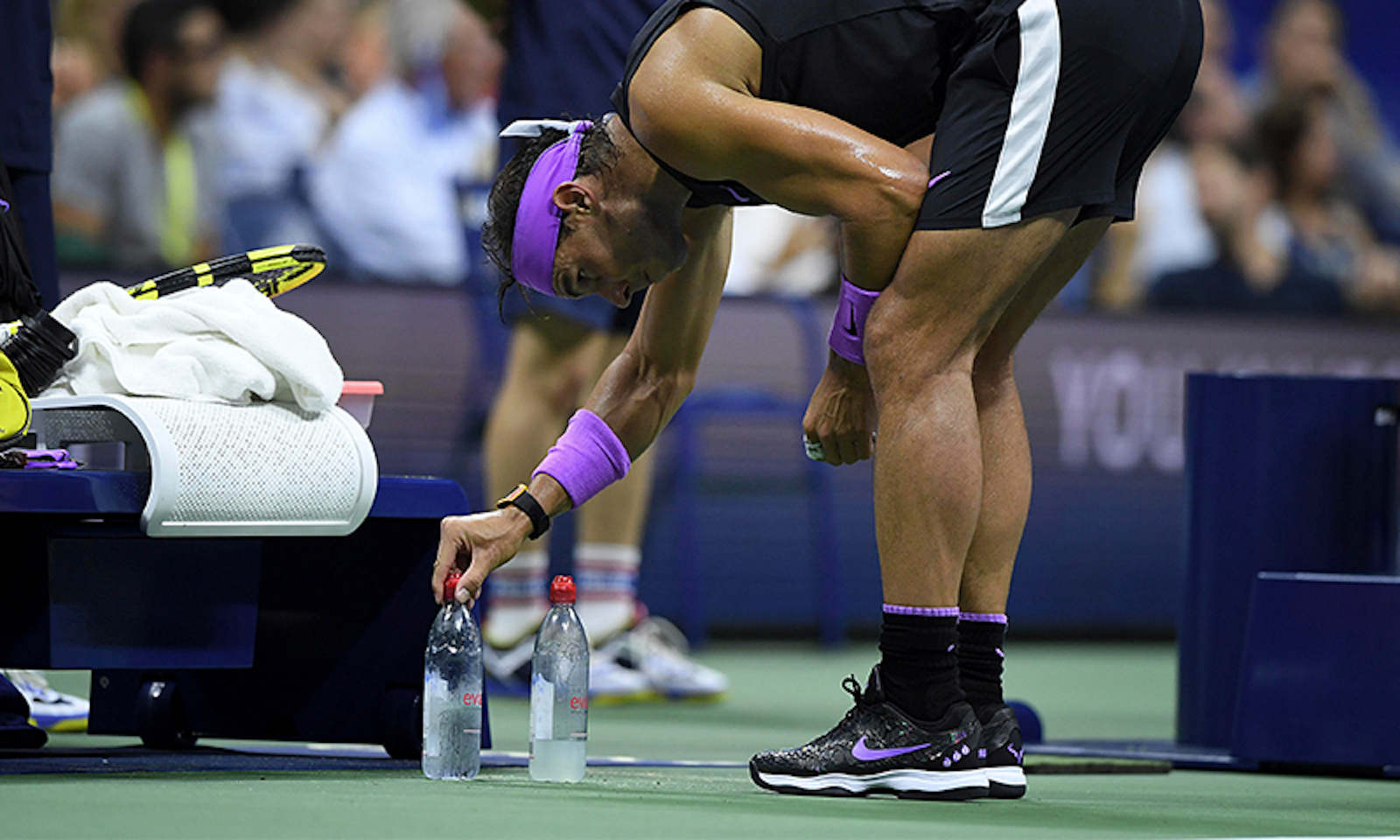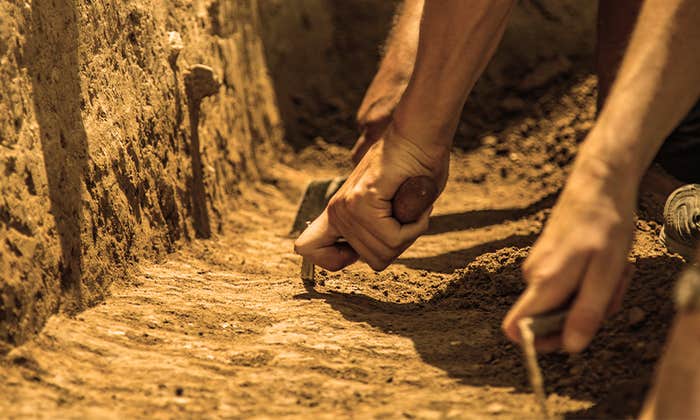Tennis star Rafael Nadal performs an elaborate repertoire of rituals before and during every match. When he arrives at the stadium, he enters the court holding a racket in his hand, taking great care never to step on the lines and always crossing each line right-foot first. He places his bag on the bench and turns his tournament ID face up. His chair must be perfectly perpendicular to the sideline. He checks his socks to make sure they are perfectly even on his calves. During the coin toss he faces the net and starts jumping until the coin falls, then runs to the baseline, where he drags his foot across the entire line in a single sweeping motion before hitting each shoe with his racket.
When the game begins, Nadal starts performing repetitive hand gestures that resemble those of Catholics crossing themselves. With his right hand he touches the back and front of his shorts, then his left shoulder, then the right, then his nose, left ear, nose again, right ear and finally his right thigh. At each changeover he picks up two towels. He waits for the other player to cross the line, and then he crosses right-foot first to take his seat. He carefully folds one towel and puts it behind him without using it. Then he folds the second towel and places it on his lap. He takes one sip from a bottle of water, then another sip from a second bottle. Very carefully, he returns the two bottles to the exact same position, the labels facing the same way.
Nadal insists he is not superstitious. In his autobiography, he writes, “Some call it superstition, but it’s not. If it were superstition, why would I keep doing the same thing over and over whether I win or lose? It’s a way of placing myself in a match, ordering my surroundings to match the order I seek in my head.” Who could deny that Nadal’s rituals don’t help him manage his anxiety and find order on the court? He is one of the greatest tennis players of all time.
Over the decades, anthropological studies, including my own, have shown that ritual practices come naturally to us, regardless of our cultures, and further, we expect them to have an effect. But is ritual really an effective stress-management strategy? Or is it simply an illusion, a waste of time or, worse, a dangerous distraction from our real problems?
Field observations suggest that ritual may indeed help people cope with anxiety. In a study conducted in Israel, researchers interviewed local women during the Lebanon War of 2006. They found that among those women who lived in war zones and experienced the stress of war, reciting psalms was associated with lower overall stress levels.1 No similar association was found for women living outside the war zones. While participants in this study were the judges of their own anxiety, similar effects were found at the physiological level.
“It’s a way of ordering my surroundings to the order I seek in my head.”
In my lab at the University of Connecticut, my colleagues and I observed a group of students during the midterm exams, one of the most stressful periods of the year. In addition to surveys, we collected hair and saliva samples, which we used to measure levels of cortisol, a hormone associated with stress. Salivary cortisol changes over the course of a few minutes, so it can be used to measure stress around a specific activity. But traces of the hormone also accumulate in our hair, and they can be used to track long-term anxiety. We found that students who participated in more rituals had lower anxiety across all these measures.
But these are correlational findings. They help us point to an association but cannot establish a causal relationship. For that, we need to turn to experimental studies. Fortunately, several experiments have been conducted on this topic in recent years.
In one of these studies, Matthew Anastasi and Andrew Newberg randomly assigned Catholic college students to either reciting the Rosary (a set of repetitive prayers) or watching a religious film, and measured anxiety levels before and after those tasks. They found that those who recited the Rosary experienced a greater decrease in anxiety.2
Alison Brooks and her colleagues found similar results when they asked participants to enact an artificial ritual that resembled a magical spell. As it turned out, performing this ritual helped people engaged in various stressful tasks such as taking a math test or participating in public karaoke to cope with anxiety.3 In another study, Michael Norton and Francesca Gino asked participants to think about a loss they had experienced—someone who had passed away, a broken relationship or even a monetary loss. They found that, when they asked some of them to perform a ritual, they were better able to cope with the anxiety caused by the loss.4

Moving from the lab into the real world, my colleagues and I designed a field experiment on the Indian Ocean island of Mauritius.5 To see whether some of the traditional local rituals helped people reduce anxiety, we measured a property of the autonomic nervous system known as heart-rate variability. A healthy heart does not beat evenly like a metronome. When we have a heart rate of 60 beats per minute, this does not mean that our heart ticks exactly once every second. Rather, it means that all the slightly different periods between each two successive beats average out as one second. This variance in the timing between beats is known as heart-rate variability. When it is high, the nervous system is more balanced, and the body is better able to respond to changing circumstances. But when we are stressed, this balance is disrupted and the heart beats in a more rigid way—it has low variability. As a result, the body maintains a state of high alert, which is experienced as anxiety.
Our study took place in a small fishing village called La Gaulette. As is often the case with such villages, most public life took place near the coast. All restaurants, shops, and other commercial activities were arranged alongside the coastal road, and so were all public services, including a police station and two places of worship: a Catholic church near the south entrance, and a Marathi Hindu temple on the north side. Sitting at the cafe each morning, we could see many of the local Hindu women, dressed in colorful saris, walk to the temple to perform religious prayers. Those prayers involved making offerings to the statues of various Hindu deities and executing circular movements with an incense burner or incense stick. These were just the kind of repetitive action patterns that we were interested in and, importantly, ones that were culturally scripted rather than dictated by the experiment.
Whether the sense of control is illusory is of little importance.
We recruited 75 of these women and split them into two groups. We asked those in the first group to meet our team at the temple. The second group arrived at a makeshift lab we had set up in a non-religious building of similar size and arrangement to the temple. This would be our control group. Participants wore a small monitor that recorded their heart beats before being invited to engage in a task that was designed to be stressful: We asked them to write an essay describing the kinds of precautions they would take when faced with an impending flood or cyclone. Such natural disasters regularly plague the island, often with catastrophic consequences, and are a constant source of anxiety for the locals. To create additional stress, we also told them that their essay would be evaluated by a group of public safety experts. After the stressor task, those who were in the temple were asked to go to the prayer room and perform their rituals in the same way as they always did. They entered the room in privacy, lit the incense, and made their offerings to the deities. Those in the control group went through the exact same procedure but performed no rituals. Instead, they were told to sit and relax.
As we predicted, the ritual had beneficial results. Reflecting on natural disasters caused a rise in anxiety for both groups. But those who performed the ritual were faster to recover from that anxiety. Their heart-rate variability increased by 30 percent, suggesting that they were better able to cope with the stress. This was also consistent with how they felt: Subjective ratings of anxiety were twice as high for those who had not performed the ritual. These are no trivial differences: Clinical studies have documented effects of similar magnitude between healthy individuals and people suffering from major depression.6 Ritual, it turns out, can be as effective in reducing stress as some of our best anxiety medications.
How can we explain these findings? Rituals are highly structured. They require rigidity (they must always be performed the “correct” way), repetition (the same actions performed again and again) and redundancy (they can go on for a long time). In other words, they are predictable. This predictability imposes order on the chaos of everyday life, which provides us with a sense of control over uncontrollable situations.
Studies show that, when people experience uncertainty and lack of control, they are more likely to see patterns or regularities where there are none. These patterns can range from visual illusions (such as seeing faces in the clouds) to seeing causality in random events and forming conspiracy theories.7 Under these circumstances people are also more likely to turn to ritualized behaviors. This is known as the compensatory control model: We compensate for lack of control in one domain by seeking it in another.8 Whether this sense of control is illusory is of little importance. What matters is that ritual can be an efficient coping mechanism, and this is why those domains of life that involve high stakes and uncertain outcomes are rife with rituals.
In the experiments conducted by Brooks and her colleagues, engaging in rituals helped participants to perform better in mathematics contests and sing more accurately in karaoke competitions. And in Israel the women who recited more psalms felt less need to take other precautions, which might have impeded them from going about their normal life. In contrast, those who did not perform as many rituals seemed overcome by anxiety. This led them to avoid public places, buses, restaurants, and large crowds after rocket attacks. This sounds very sensible until you learn that, even at the height of the conflict, the chances of getting killed in a terrorist attack in Israel were lower than those of dying in a car accident. Living in fear could do more harm than good, and rituals helped those women deal with their fears and live a normal life in the face of the conflict.
Our predictive brain does not like unpredictability.
Similar effects extend to a variety of other domains. A group of German psychologists found that people who used lucky charms and rituals such as keeping their fingers crossed performed better in an assortment of skill games and puzzles.9 Other studies have found that ritualization may help athletes perform better. Basketball and golf players are more successful after performing pre-shot rituals.10 Stopping them from performing these rituals can be detrimental to their performance, leading them to miss more shots.11 The reason for these remarkable effects appears to be that these rituals allow the athletes to ease their own anxiety, regaining a sense of control.
In recent years, philosophers, psychologists, and neuroscientists have revised their models of the human mind. The classical view was that our cognitive apparatus functions as a data-processing device: It receives input from the environment and reacts by producing the appropriate responses. But evidence has been mounting that our brain is much more sophisticated than that. It is a predictive device. Rather than passively absorbing information about the state of the world, it actively works to make inferences (predictions) about what types of stimuli it is most likely to encounter at any given situation. Those predictions are based on information derived from our prior experience and socialization, our surroundings, as well as hard-wired knowledge.
Take the blind spot in our vision. The optic nerve, a bundle of nerve fibers that carry information from the eye to the brain, passes through the retina itself. Consequently, the spot where the optic nerve enters the eyeball has no photoreceptor cells to detect light. This is why it is called a blind spot: Whatever part of our visual field falls on to that spot becomes invisible to us. If you had never noticed that you have a blind spot, that is because your brain makes up the missing part of the image by using information from the surrounding environment to fill in the gap.
Our brain makes similar types of inferences in all sorts of other domains. Imagine that you live on the outskirts of San Francisco, and as you wake up you feel your bed shake. Fearing it might be an earthquake, your immediate response might be to try to get out of the building as quickly as possible. But now imagine that you live in New York, which does not experience many earthquakes, and that an elevated train line runs alongside your building. Perhaps the first time that you wake up to the vibration you rush to the door, only to embarrass yourself as you run down the hallway in your underwear. But once you know what to expect when you feel the shake, it will no longer cause you to panic. As your brain has now updated its prior knowledge, it can predict with greater confidence that the shaking will not cause the roof to fall on your head. The situation is no longer stressful. In fact, over the years, the familiar sensation of the train going by at regular intervals may even start to feel comforting.
Because our brain never stops making these kinds of predictions, we tend to look for patterns and statistical regularities everywhere around us. This is extremely important, because any computational device (and the human brain is no exception) becomes dramatically more efficient when it can build on prior knowledge. This way, we do not have to learn everything from scratch. But one consequence of this cognitive architecture is that when our predictive potential is limited—that is, when there is high uncertainty—we experience anxiety. Our predictive brain does not like unpredictability.
This is where ritual comes in. The repetitive action patterns found in ritual function as cognitive gadgets that help us cope with stress. By embedding these gadgets into our cultures, all human societies—and its individuals—can capitalize on their potential.
Just ask Rafael Nadal. ![]()
Dimitris Xygalatas is an anthropologist and cognitive scientist who studies some of the things that make us human. Most of his research has focused on rituals and their ability to soothe, excite, unite, and divide us. To study these effects, he combines ethnographic field work with scientific experiments. He is based at the University of Connecticut, where he directs the Experimental Anthropology Lab.
Excerpted from Ritual: How Seemingly Senseless Acts Make Life Worth Living, by Dimitris Xygalatas. Copyright © 2022 by Dimitris Xygalatas. Used with permission of Little, Brown and Company, an imprint of Hachette Book Group. New York, NY. All rights reserved.
Lead image: Sipa USA via AP Images
References
1. Sosis, R. & Handwerker, P. Psalms and coping with uncertainty. American Anthropologist 113, 40–55 (2011).
2. Anastasi, M.W. & Newberg, A.B. A preliminary study of the acute effects of religious ritual on anxiety. Journal of Alternative and Complementary Medicine 14, 163–165 (2008).
3. Brooks, A.W., et al. Don’t stop believing: Rituals improve performance by decreasing anxiety. Organizational Behavior and Human Decision Processes 137, 71–85 (2016).
4. Norton, M.I. & Gino, F. Rituals alleviate grieving for loved ones, lovers, and lotteries. Journal of Experimental Psychology: General 143, 266–272 (2014).
5. Lang, M., Krátký, J., & Xygalatas, D. The role of ritual behaviour in anxiety reduction: An investigation of Marathi religious practices in Mauritius. Philosophical Transactions of the Royal Society B 375, 20190431 (2020).
6. Udupa, K., et al. Alteration of cardiac autonomic functions in patients with major depression: A study using heart rate variability measures. Journal of Affective Disorders 100, 137–141 (2007).
7. Whitson, J.A. & Galinsky, A.D. Lacking control increases illusory pattern perception. Science 322, 115–117 (2008).
8. Hockey, G.R.J. Compensatory control in the regulation of human performance under stress and high workload: A cognitive–energetical framework. Biological Psychology 45, 73–93 (1997).
9. Damisch, L., Stoberock, B., & Mussweiler, T. Keep your fingers crossed! How superstition improves performance. Psychological Science 21, 1014–1020 (2010).
10. Gayton, W.F., Cielinski, K.L., Francis-Keniston, W.J., & Hearns, J.F. Effects of preshot routine on free-throw shooting. Perceptual and Motor Skills 68, 317–318 (1989).
11. Foster, D.J., Weigand, D.A., and Baines, D. The effect of removing superstitious behavior and introducing a pre-performance routine on basketball free-throw performance. Journal of Applied Sport Psychology 18, 167–171 (2006).


























